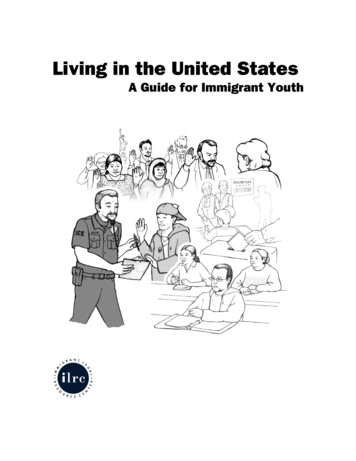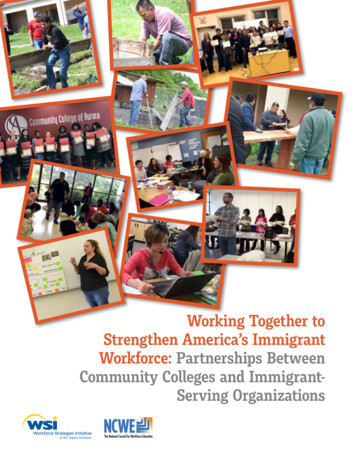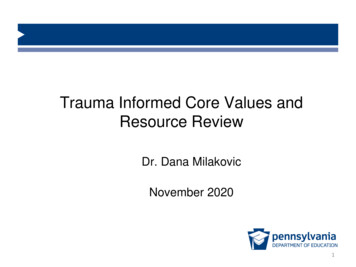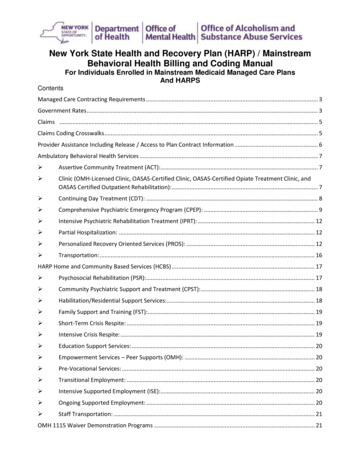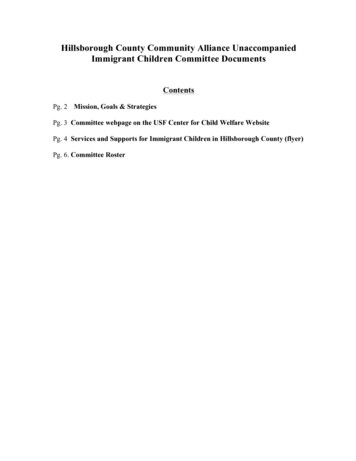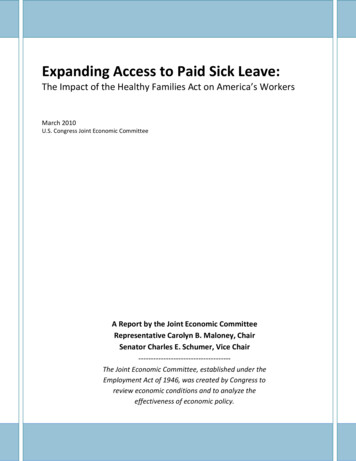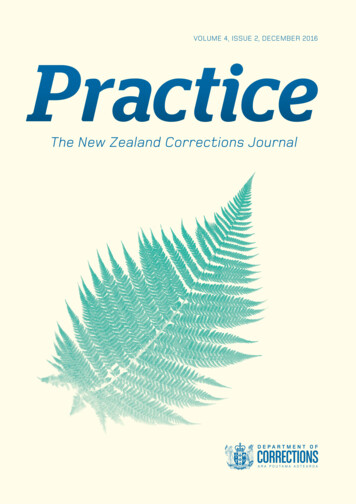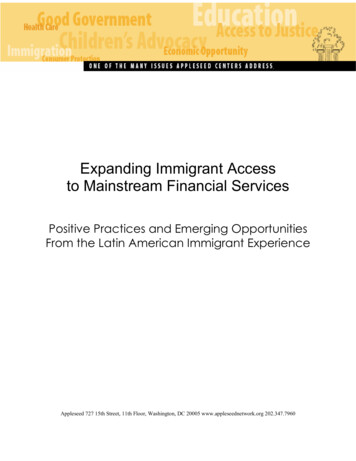
Transcription
Expanding Immigrant Accessto Mainstream Financial ServicesPositive Practices and Emerging OpportunitiesFrom the Latin American Immigrant ExperienceAppleseed 727 15th Street, 11th Floor, Washington, DC 20005 www.appleseednetwork.org 202.347.7960
ACKNOWLEDGEMENTSThis report is generously supported by grants from the Ford Foundation and the Annie E.Casey Foundation. We would like to offer a special thanks to Gerald Buechler and ScottKimpel of Akin Gump Strauss Hauer & Feld LLP and to Kathleen Scott of White & CaseLLP for their contribution to this report.Appleseed Staff:Immigrant Access to Financial Institutions ProjectDirector:Linda Singer, Executive Director, AppleseedReport Contributors:Ann Baddour, Senior Policy Analyst, Texas AppleseedJulie Dona, Research Associate, Chicago Appleseed Fund for JusticeSharon Hill, Executive Director, Georgia AppleseedKerry Kolodziej, PILI Fellow, Chicago Appleseed Fund for JusticeRebecca Lightsey, Executive Director, Texas AppleseedMalcolm Rich, Director, Chicago Appleseed Fund for JusticeDarcy Tromanhauser, Coordinator, Immigrant Integration and Civic Participation Program,Nebraska AppleseedAppleseed, a non-partisan and non-profit organization, is a network of public interest lawcenters working to identify and address injustices in their communities. Appleseed works tobuild a just society through education, legal advocacy, community activism, and policyexpertise, addressing root causes and producing practical solutions. As one of the nation’slargest legal pro bono networks, Appleseed Centers work both independently and collectively,bringing their own experiences to create local solutions that are nationally relevant. Weconnect the top private practice lawyers, corporate counsel, law schools, civic leaders, andother professionals to tackle problems locally, at their root cause.
Table of ContentsIntroduction. 1Avenues for Community Partnerships. 4Financial Education: An Important Component ofImmigrant Banking Strategies . 8Banking Outside the Box: Altering the BankingParadigm to Reach Immigrant Communities . 11Accessing Credit to Build Assets in Low-IncomeImmigrant Communities . 16Regulatory Challenges for Serving Foreign Nationals. 21Conclusion . 25Appendix A: Profiles of Successful Immigrant Banking Initiatives. 26Appendix B: Regulations Linkes to Banking Foreign Nationals . 39References. 48
IntroductionFinancial institutions looking to increase their customer base have become increasinglyinterested in reaching out to untapped immigrant markets, particularly the large numbersof Latin American immigrants who have migrated far beyond the U.S.-Mexican border toother regions of the country. Latin American immigrants in the United States numberednearly 18 million in 2004, with all immigrants reaching just over 34 million.1Many articles have been written on the topic of providing financial services toimmigrants, and new remittance and loan products have been launched to give recentimmigrants with and without legal immigration status access to the formal financialservice sector.Some innovative approaches, tailored to meet Latin Americanimmigrants’ financial service needs, are making inroads. These approaches include: Accepting foreign-issued identification to open accounts;Using the Individual Taxpayer Identification Number (ITIN)2 as a tool forproviding an expanded array of financial services, including loans;Increasing branch presence in immigrant communities;Offering financial education to immigrant consumers; andProviding check cashing and remittance products designed for low-dollar cashtransfers.Yet, there still remain a large number of immigrants who are reluctant to use formalfinancial institutions, feel product offerings do not meet their needs, or face other entrybarriers. These issues are compounded by a poor flow of information between immigrantcommunities and financial institutions, banks’ limited access points into the communities,and the absence of protection from predatory financial practices. While banks and creditunions are working to capture this market, the informal sector continues to gain ground.Stored value cards are increasingly marketed to immigrants, and check cashingbusinesses continue to grow.Defining the IssuesUsing financial institutions to conduct basic financial transactions is the first step towardsintegration of immigrant communities into the mainstream financial service system.Among Latin American immigrants—the primary target to date for mainstream financialservice marketing efforts—a high proportion remains unbanked. According to a studycommissioned by the Pew Hispanic Center, 35 percent of Ecuadorians, 64 percent ofSalvadorans, and 75 percent of Mexican immigrants do not have bank accounts.3 Many12004 American Community survey.The ITIN, issued by the Internal Revenue Service, enables people who owe federal income taxes but donot qualify for a Social Security Number to file taxes.3Manuel Orozco, The Remittance Marketplace: Prices, Policy and Financial Institutions, Pew HispanicCenter, June 2004, page 19.21
have never had an account and generally lack familiarity with the banking system, whileothers have had a negative experience with the banking system in the U.S. or in theirhome countries.Low-income immigrant consumers tend to remain unbanked or dissatisfied withmainstream financial institutions for a variety of reasons:4 high costs of maintainingbank accounts; difficulties overcoming poor credit status; inconvenience of locations,hours, or services; distrust of banks; low levels of financial literacy; perceived culturaldifferences or language barriers; and a lack of information about appropriate products andservices. These barriers are compounded for recent immigrants, who may be unsure ofhow banks will use their personal information or of which identifying documents arenecessary to open an account.Another barrier to this population's integration into the mainstream financial system is thefact that many may not view the services they do use—such as check-cashing or sendingmoney home to their country of origin—as financial services, and they may not associatethese services with banks. As one observer put it, to many recent immigrants, suggestingthat they use a bank to remit money to their home country may appear as “reasonable” asrecommending they buy a car at the grocery store.However, lack of access to the mainstream financial system presents a host of problems,for immigrant communities and for our society as a whole. Individuals outside thefinancial mainstream find their opportunities for economic advancement and stabilitythwarted, as they are unable to obtain credit to buy a home or finance a business, gaininterest on their savings, save for their children’s education, or enjoy any of the otherbenefits that the banking system has to offer. Money lost to the high fees and interestrates charged by fringe financial services is money that could have been reinvested infamilies and local communities. Immigrants who carry large sums of money on payday,instead of using a bank or credit union account, are more vulnerable to robbery and otherviolent crime.Financial institutions that have reached out to immigrant communities have met with bothchallenges and successes. Examples of challenges include: Creating new international remittance product offerings but facing difficulties inencouraging community members to use of the products; andMaking inroads into communities, with new immigrants opening accounts, onlyto have the accounts lie dormant with little money or activity.Though there is no denying the challenges, there are also many successes: 4Banking services in accessible locations, such as local grocery stores or smallstorefront locations in immigrant communities, have been successful intransitioning low-income immigrants into the banking system;Williams 2000, page 2.2
Some financial institutions report average account balances for Mexicanimmigrants in the range of 2,000; andSmaller financial institutions have credited new immigrant communities withrevitalizing their business and other financial institutions have been launchedprimarily to serve immigrant community needs.This paper aims to stimulate a discussion on how best to overcome challenges and buildon successes to realize the important social and economic benefits of bringing immigrantcommunities into the financial mainstream. It outlines positive market practices targetingLatin American immigrants and sets the groundwork for exploring their application toother immigrant communities. It will: Define key avenues for community partnerships;Explore successful financial education approaches;Present alternative banking approaches that attract immigrant customers;Detail ways that financial institutions can profitably provide low-incomeconsumers with access to credit; andReview key regulatory issues related to serving foreign nationals.Appendix A profiles examples of positive market practices in the areas highlighted by thereport and Appendix B provides an overview of financial institution regulations thatimpact serving foreign nationals.“Questions to Consider” are provided to inspire creative problem-solving and discussionof next steps to improve financial opportunity for immigrant communities.General Questions to Consider: What combination of product offerings and pricing would make low-incomeimmigrants feel that they are better off using banks or credit unions than themore familiar informal services?Is there a “one size fits all” approach to serving low-income immigrantcommunities, or is each community unique to the point of requiring differentproducts and approaches for financial institution engagement?Does the traditional progression of using financial services—starting with atransactional account, building savings, building credit through credit cards andsmaller loans, then moving on to home mortgage and business loans—meet theneeds of immigrant communities?Do immigrants have specific financial service needs that currently are not partof the dialogue, perhaps loans to process immigration paperwork, a focus oneducation financing for children of immigrants, financial services thataccommodate migratory and seasonal work, or other services?3
Avenues for Community PartnershipsFinancial institutions must earn the trust of immigrants to serve the immigrant market.Some financial institutions have earned trust through partnerships with communityorganizations that understand unique community needs.5 These organizations providevaluable insight into the market as well as strategies to improve product offerings andbroaden market penetration. Community organizations can use their clout to negotiatefairly priced financial services. Banks and credit unions can offer resources, such as staffand money that they are often willing to devote to increasing clientele.While the benefits of alliance-building with community groups are increasingly acceptedin the banking industry, financial institution partnerships with community organizationsremain the exception rather than the rule. Though both parties see the mutuallybeneficial goal of providing banking services to an unbanked community, theirexpectations from the relationship may be very different. Banks have a distinct interestin serving their communities, but profitability is the end goal, and the two are not alwaysperceived to go hand in hand. Community organizations may expect services and pricingthat financial institutions cannot offer profitably, at least not to scale. Financialinstitutions may become frustrated when organizations do not deliver new customers.Another challenge is finding the right match between financial institutions andcommunity organizations. Large banks serving multiple communities face difficulties inoffering products for a niche market in one community. As a result, the largest bankshave tended to seek out partnerships with national organizations such as the Associationfor Community Organizing Now and the United Farm Workers Union. Though theseorganizations have strong community roots, many immigrants are not linked to thesegroups. Hometown associations and other social clubs and social service organizationsthat have grown out of recent waves of immigration are largely local and usually left outof financial partnership opportunities. Smaller banks are more flexible and capable ofmeeting niche market demands and more willing to explore local partnerships, but theyhave less capacity to subsidize a line of products with the hope of long-term profitability.Questions to Consider: What makes a partnership successful for both the bank and the organization?How can financial institutions improve outreach to new immigrantorganizations?How can community organizations balance positive relations with partnerbanks and their advocacy role to protest undesirable bank practices?How can financial institutions find community partners that view the bank asmore than a potential funding source?What types of partnerships are most effective in achieving broader marketimpact?5See Jacob 2000 and Newberger 2004 for additional discussion on the utility of community organizationsin promoting financial literacy and services.4
Opportunities for PartnershipsDespite the difficulties outlined above, there are promising examples of successfulpartnerships. Community-based organizations can and have joined with banks and creditunions in a number of important ways. Advice and Advocacy. An important function of partnering with a bank or creditunion is providing feedback and evaluation of the institution’s programs,products, and services.6 Organizations with direct links to the community areoften better equipped to determine how the target audience is responding to aninstitution’s efforts. For example, members of Chicago CRA Coalition oftenmeet with bank representatives to learn about and provide feedback on specificprojects. On one occasion, the Coalition members helped Bank One create alifeline banking account, and discussed account features, regulatory andoperations barriers, promising pilot locations, financial literacy, and marketing.7 Promoting Beneficial Products and Services. Community organizations candevelop formal relationships to provide specific financial products and services toconsumers. For example, in 2004, H & R Block partnered with government andcommunity organizations in several different cities to develop and deliverfinancial and retirement services to low-income residents.8 Once assured that theproducts and services offered would benefit their constituents, organizations andlocal government agencies used their connections to bring customers to the firm.Community organizations are best served by multiple such partnerships so thatthey do not promote one business option for their constituents, to the exclusion ofothers. Delivering Financial Education. The Consumer Bankers Association’s annualsurvey of bank-sponsored financial literacy programs reveals that there are manysuccessful partnerships between banks and community-based organizations thatare helping to educate immigrants about financial issues and providing access toproducts and services to meet immigrants’ unique needs.9 One financialeducation partnership involved Branch Banking & Trust (BB&T) in WinstonSalem, the North Carolina Office of Hispanic/Latino Affairs, and El Pueblo, anon-profit group. A series of hour-long Spanish language audiotapes in a novelaformat (told as a soap opera-like story) were distributed through churches andcommunity groups to help educate immigrants about getting a driver’s license,establishing credit, basic banking, buying a car, and the role of the FDIC.10Although there are many successful partnership programs in place, there is a need foradditional growth in this area. In 2004, only 47% of banks surveyed reported6See, for example, page 42 in Consumer Bankers Association, 2004.Williams, Marva, 2000, page 6.8Center for Financial Services Innovation, July 2005.9See Consumer Bankers Association, 2005.10Consumer Bankers Association, 2003, page 6.75
involvement with a personal finance program or initiative specifically targeting theunbanked.11Building Community Assets: A Guide to Credit Union Partnership, published by theWoodstock Institute in 2004, is a useful guide for non-profits that are consideringpartnerships with credit unions.12 It also specifies features of a model access account forunbanked individuals.Partnering with Government AgenciesNon-profit organizations can work with consulates of foreign governments to helpprovide relevant financial services to immigrant consumers. For example, the MexicanConsulate in Chicago sees thousands of Mexicans daily and can provide quick referrals tonon-profit organizations and financial institutions. Chicago Appleseed has providedfinancial education materials to thousands of Mexican immigrants through the MexicanConsulate. Fifteen different banks offer financial literacy programs at Chicago’sMexican Consulate on a rotating basis and also help immigrants open accounts—onebank has opened 3,000 accounts through the consulate.13The Federal Deposit Insurance Corporation has spearheaded a broad collaborativeinitiative called the New Alliance Task Force. The Task Force has successfully linked awide range of non-profit, government, and banking entities for the purpose of improvingproducts and services for recent immigrants.Local government agencies also have a stake in promoting financial services forimmigrants, often because of safety concerns. Police departments in various cities haveseen immigrants become targets for crime because they often carry large amounts of cashafter cashing paychecks. In Austin, Texas, the police department, the Texas Secretary ofState, the Mexican Consulate, and Wells Fargo Bank partnered to give presentations tothe community about the safety of bank accounts and how to use them in order to reducerobberies and assaults targeting the community.14 This effort resulted in Wells Fargobecoming the first bank to accept the matrícula consular as a form of identification foropening bank accounts.15 It is now a widely accepted practice for banks to honor thisidentification card.Other local police departments have gotten involved in financial education as a strategyto reduce crime against immigrants. Police departments in Los Angeles and Chicagohave developed programs to teach Latin American immigrant communities about using11Consumer Bankers Association, 2005, page 5.This report, along with other Woodstock Institute publications, can be found s 2005 (Personal Interview)14Wells Fargo Bank15Wells Fargo Bank and City of Austin, Texas (May 2, 2001).126
bank accounts. With the help of community groups, more communities can follow theirlead.Connecting with Local Immigrant AssociationsIn many cities there are strong immigrant networks and community groups. Hometownassociations (HTAs) are prevalent in cities with large immigrant populations. Hometownassociations formed by Mexican immigrants bring together immigrants from the sameMexican state. Members of the same HTA work together to transfer money and otherresources back to their communities of origin, to promote local economic development.They function as civic and cultural centers within the community, organizing holidaycelebrations, scholarship fundraisers, and other activities. In communities where there isa large Mexican immigrant population, federations exist to bring together the efforts ofdifferent HTAs representing the same Mexican state. According to the MexicanConsulate, as of 2004, there were 13 federations of hometown associations in Chicagoalone.16Other non-profit organizations can form alliances with hometown associations by sharinginformation and providing institutional support. For example, the Chicago-based nonprofit Enlaces América, along with several Midwestern Mexican hometown federations,established a leadership certification program called the Chicago Immigrant LeadershipEmpowerment Program. The program, started in 2002, brings together leaders from theHTAs and trains them on topics such as strategic planning and fundraising. Althoughthis program does not have links to banking, it is illustrative of the positive impactpartnerships can bring to immigrant communities.Moving from Partnerships to Banking ImmigrantsSome of the most successful models for bringing financial services to the immigrantcommunity have been built on strong partnerships. These partnerships have been able tofashion viable, replicable answers to some of the most pressing financial needs ofimmigrant communities. The following sections discuss how partnerships and otherstrategies can contribute to the success of financial education, basic banking, and lendingprograms in immigrant communities.16ENLACES AMÉRICA, 2004.7
Financial Education: An Important Componentof Immigrant Banking StrategiesOver the past five years, financial education has received increased funding and attention.Hundreds of curricula and materials exist, including those that target particular immigrantgroups or are translated into multiple languages. The consensus around financialeducation is that it is important to effectively transition unbanked and underbankedindividuals into the formal financial service system and into successful borrowers. Muchdebate exists around how effective financial education efforts have been.A report issued by the National Council of La Raza in December 2005 asserts that currentfinancial education efforts are not sufficient to meet the needs of low-income andunbanked communities. The report calls for an increase in long-term, one-on-onefinancial counseling by trained financial counselors, because research has shown thisapproach to have the greatest impact on individual and family financial behaviors.Given the lack of resources to support efforts targeting low-income communities, it isunlikely that such a high level of personal financial education will be broadly available inthe near term. Yet, acknowledging the importance of financial education, how canfinancial institutions and community organizations most effectively provide financialeducation to immigrant communities within the confines of their capacity?Financial education is an area that is ripe for partnerships between financial institutionsand community organizations. It also lends itself to collaboration among communityorganizations. It is, however, not the only answer to helping consumers avoid costlyfinancial service decisions. There must also be efforts to improve market products andpractices to encourage the creation of asset building rather than asset depleting financialservices in low-income immigrant communities.Questions to Consider: What financial education approaches have the greatest impact on consumerbehavior?Who is the best provider of financial education? A financial institution thatcan tie education to specific products and outcomes, community educatorswho have the community’s trust, or a combination?Do immigrants need uniquely tailored curricula and approaches, or doexisting curricula for the unbanked generally meet their financial educationneeds?How can financial institutions effectively offer financial education in abusiness environment where customer account mismanagement and poor loanchoices can provide a source of fee income and profit?8
Financial Education as a Tool for BuildingLong-Term Banking RelationshipsProviding appropriate financial education is essential to a successful long-term bankingrelationship between financial institutions and previously unbanked families. Thiseducation must surmount a basic lack of familiarity with the banking system and often afundamental distrust of that system.Successful approaches recognize the realities of immigrant community members’ lives—that building trust and communicating respect is a key component of financial education,that educational efforts have to be conducted outside the branch bank and beyondtraditional classes, and that the process is a two-way street requiring education not onlyof potential new customers but of financial institution staff about the new customers theyseek to serve. Effective financial education initiatives have incorporated one or more ofthe following elements: Developing Trust. This is probably the most important aspect of financialeducation and the one that makes the greatest difference in banking newcustomers. Financial education initiatives that take into account this significantcultural aspect of doing business are far more successful than those that jump tooquickly into the specifics of bank products. The most effective initiatives makethis a core component of education efforts. Starting with the Basics. Financial education of the unbanked must begin withvery basic information about the banking system, its benefits, and why it can betrusted. Covering the basics sets the stage for unbanked individuals to take aninterest in additional financial education. Colorful, easy-to-read materialsdesigned specifically for this audience (rather than simple translations of existingmaterials), word-of-mouth, and radio advertisements have all proven effective inreaching out to the unbanked. Staffing, Décor, and Branch Site Decisions. Convenience, family-friendlyservice, cultural sensitivity in manner and décor, and language, are important forbuilding trust and making immigrants feel welcome. Financial institutions arefinding that all of these can be part of effective financial education. Viewing Financial Education as a Two-Way Street. The most effective banksand credit unions have taken the approach that education is a two-way street. Allstaff—from top to bottom—are educated about community members the bankhopes to serve in addition to educating community members about the bank. Taking Education to the Community. It is well established that simply offering aclass is not an effective way to reach a community whose time is stretched thinand who may not yet be familiar with the advantages of learning more aboutmainstream financial services. ESL classes, worksites, day labor waiting sites,lunch breaks, after church, community social gatherings, non-financial workshops9
(such as parenting classes), consulate outreach clinics, or other places individualswait offer valuable opportunities for financial education. It is crucial to lookbeyond traditional classroom-style education to bring information into thecommunity and into informal settings. Some organizations and financialinstitutions are going door to door with information or sending mobile financialeducation centers into different neighborhoods. Incorporating field trips to banks,home inspections, or home closings has also proven successful. Forging Key Partnerships. Collaboration is critical to reaching new customers.Because many immigrant customers tend to be skeptical of banks at first,cooperative efforts that provide neutral information through multiple financialinstitutions and trusted community groups can be an important first step inrelationship-building with potential new customers. Some banks and credit unionshave collaborated effectively to provide rotating staff to teach multi-week classes,making less of a sales tactic impression. Financial Education as Part of Asset, Credit Building. Many financialinstitutions and community organizations have partnered to make financialeducation a requirement of Individual Development Account (IDA) programs orcredit-building savings programs.17 Such an approach accomplishes bothfinancial education and the development of important assets or a credit history. An Essential of Good Customer Service. While getting outside the branch maybe the most important aspect of successful education initiatives, financialinstitutions are also incorporating financial education into all of their internalprocesses and services to great effect. The account opening process is animportant learning moment to provide new customers with solid information onhow to use the new account and how to avoid misusing it with overdrafts, forexample. Evaluating their systems from the first moment a customer walksthrough the door through each banking service they might use identifies manypotential moments to provide financial education. Addressing Other Immigrant Community Needs. In addition to incorporatingintroductory financial education into non-financial workshops, financialinstitutions also describe the important signal they send community members bymaking an effort to address non-financial issues in bank-sponsored events. Somehave invited additional community resources, such as immigration attorneys, to bea part of their financial education events in order to recognize and help addressother community needs.Whether introducing the basics of the financial system or covering next-step topics, suchas deposit and checking products, building or restoring good credit, budgeting andfinancial planning, and first-time home ownership, these strategies and approaches areproving effective in welcoming new immigrant customers into the banking system.17An IDA is a matched savings account that can be designated for a specific purpose, such as saving foreducation or a home.10
Banking Out
families and local communities. Immigrants who carry large sums of money on payday, instead of using a bank or credit union account, are more vulnerable to robbery and other violent crime. Financial institutions that have reached out to immigrant communities have met with both challenges and successes. Examples of challenges include:

